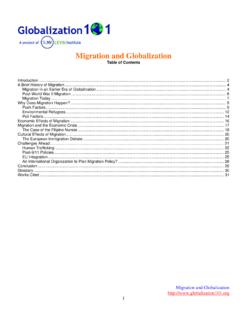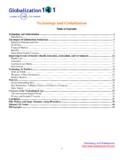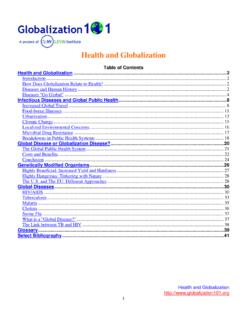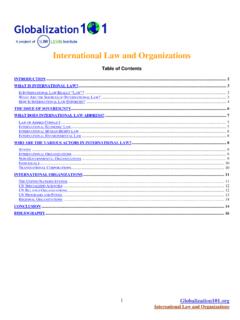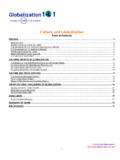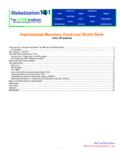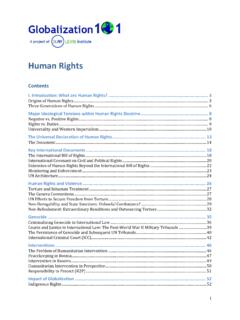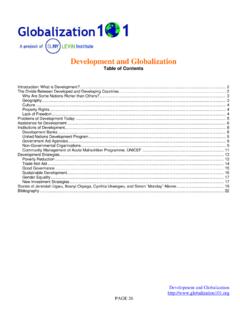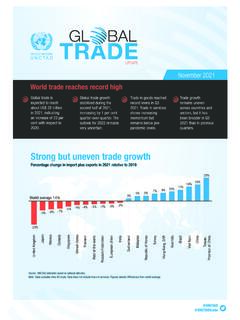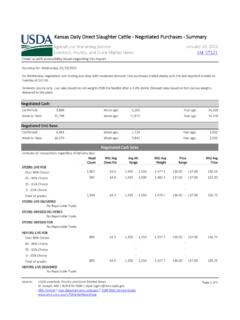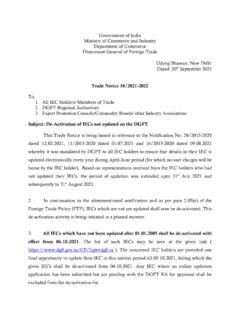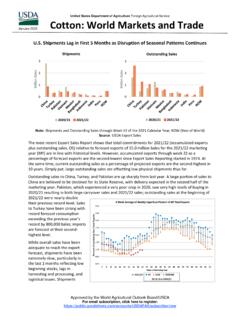Transcription of Trade and Globalization
1 Trade and Globalization 1 Trade and Globalization TABLE OF CONTENTSTRADE AND Globalization .. 2 INTRODUCTION .. 2 A SNAPSHOT OF Trade .. 3 PRIMER 1: THE ECONOMICS OF INTERNATIONAL Trade .. 8 INTERNATIONAL Trade IN HISTORY .. 8 WHY DO NATIONS Trade ? .. 9 WHY DO NATIONS EXPORT? .. 10 CURRENCIES AND EXCHANGE RATES .. 13 WHY DO NATIONS IMPORT? .. 15 Trade SPECIALIZATION .. 17 THE THEORY OF COMPARATIVE ADVANTAGE .. 19 COMPARATIVE ADVANTAGE VERSUS ABSOLUTE ADVANTAGE .. 21 THE Trade BALANCE .. 23 PRIMER 2: GOVERNMENT REGULATION OF Trade ..26 EFFORTS TO MANIPULATE Trade FLOWS .. 26 IMPORT RESTRICTIONS .. 27 EXPORT SUBSIDIES .. 30 CONSEQUENCES OF Trade RESTRICTIONS .. 31 TARIFF DEBATES IN HISTORY .. 32 LIBERALIZATION: THE DEREGULATION OF INTERNATIONAL Trade ..34 LIBERALIZATION OF INTERNATIONAL Trade .. 37 MULTILATERAL Trade LIBERALIZATION: THE URUGUAY ROUND AND THE WORLD Trade ORGANIZATION .. 39.
2 39 THE DOHA DEVELOPMENT ROUND: THE WORLD Trade ORGANIZATION S CONTROVERSIAL AGENDA .. 40 REGIONAL Trade LIBERALIZATION .. 41 THE CHANGING COMPOSITION OF Trade .. 43 Trade CHALLENGES FOR THE UNITED STATES .. 44 PUBLIC CONCERNS ABOUT Trade .. 46 PUBLIC CONCERNS ABOUT Trade .. 47 Trade AND INTERNATIONAL LABOR STANDARDS .. 48 Trade AND ENVIRONMENTAL STANDARDS .. 50 COMPARATIVE ADVANTAGE QUIZ .. 51 GLOSSARY ..52 WORKS CITED ..54 Trade and Globalization Introduction The tremendous growth of international Trade over the past several decades has been both a primary cause and effect of Globalization . The volume of world Trade increased twenty-seven fold from $296 billion in 1950 to $8 trillion in Although international Trade experienced a contraction of percent in 2009 the steepest decline since World War II Trade is again on the As a result of international Trade , consumers around the world enjoy a broader selection of products than they would if they only had access to domestically made products.
3 Also, in response to the ever-growing flow of goods, services and capital, a whole host of government agencies and international institutions have been established to help manage these rapidly developing trends. Although increased international Trade has spurred tremendous economic growth across the globe raising incomes, creating jobs, reducing prices, and increasing workers earning power Trade can also bring about economic, political, and social disruption. Since the global economy is so interconnected, when large economies suffer recessions, the effects are felt around the world. When Trade decreases, jobs and businesses are lost. In the same way that Globalization can be a boon for international Trade ; it can also have devastating effects. The following Issue in Depth is designed to help you understand some of the fundamental economic principles behind international Trade , familiarize you with some of the technical terms, and offer some insight into a few of the controversies surrounding international Trade policy both in the United States and abroad.
4 1 World Trade Organization. (2007). 2 World Trade Organization. (2010). A Snapshot of Trade In the year 2011, Americans sold $ trillion in goods and services to corporations and consumers in other countries. Goods and services sold to other countries are called exports. In 2011, Americans also bought roughly $ trillion in goods and services from other Purchases from other countries are called imports. The sum of exports and imports, $ trillion, represents the total of international Trade for 2011. Each day, in fact, Americans buy and sell more foreign goods and services than are produced annually in more than 80 countries around the world. That means that companies, and the average American citizen, are avid consumers we buy a lot from other countries. We also produce a great deal to sell to other countries; the is one of the top five exporters Below we take a closer look at some of the data and trends that describe the recent Trade performance of the United States and the rest of the world.
5 Figure 1: Exports for 20105 3 United States Census Bureau. (2011). 4 Central Intelligence Agency. (2012). 5 See citation 3. Figure 2: Imports for 20116 6 ibid. Exports(YTD). Imports (YTD). Total=1, Figure 3: Top Trading Partners for Year End 20117 Let sstart by comparing Figures 1 and 2. These two pie charts illustrate our trading relationships with our largest trading partners. Looking at Figure 1, we can see that Canada is our largest buyer in relation to other countries buying our goods and services, they consume the most. After Canada, Mexico is our next largest buyer. So, geographically, our neighbors are buying the majority of our exports. Looking at Figure 2, the breakdown of US imports for 2010, you can see that the vast majority of our imports are bought from China. This probably comes as no surprise given the ubiquitous Made in China label.
6 After China, we also purchase a great deal from Mexico and Canada. In contrasting these two pie charts, one can observe that for the majority of our Trade relationships there is no one-for-one trading occurring. Over time this leads to Trade imbalances, where one country buys much more than it sells to another country. The currently has a Trade imbalance with China. In 2011, the Trade imbalance with China was valued at approximately 295 7 Ibid. 8 United States Census Bureau. (2012). Trade in goods with China. Total Trade (YTD).Total=2, The fact that the economy is so large (it contains so many products and consumers) leads some to wonder whether the United States actually needs to Trade with other countries at all. This Issue in Depth addresses the questions of: Why do nations choose to Trade with other nations? How do they decide which goods to export, which to import and with whom?
7 What impact does Trade have on the economies of other nations? How do governments cope with these impacts? How has Trade changed over the past few decades? What concerns do Americans have about international Trade ? The United States will be the focus of the discussion, but many of the key ideas apply equally well to other countries. To gain a deeper understanding of the fundamentals of international Trade , a short primer on the economic theory behind imports and exports follows this section. Concepts such as comparative advantage, exchange rates, Trade specialization, and Trade restrictions are explained in detail in this section. Readers who feel well-grounded in these concepts may wish to skip to the section on Trade liberalization, which explores efforts to promote international Trade and some of the ongoing controversies about Trade policy. Primer 1: The Economics of International Trade International Trade in History Before we begin a discussion about why nations Trade , it would be helpful to take a moment to consider the character and evolution of Trade .
8 It is important to keep in mind, first, that although we frequently talk about Trade "between nations," the great majority of international transactions today actually take place between private individuals and private enterprises based in different countries. Governments sometimes sell things to each other, or to individuals or corporations in other countries, but these comprise only a small percentage of world Trade . Trade is not a modern invention. International Trade today is not qualitatively different from the exchange of goods and services that people have been conducting for thousands of years. Before the widespread adoption of currency, people exchanged goods and some services through bartering trading a certain quantity of one good or service for another good or service with the same estimated value. With the emergence of money, the exchange of goods and services became more efficient. Developments in transportation and communication revolutionized economic exchange, not only increasing its volume but also widening its geographical range.
9 As Trade expanded in geographic scope, diversity, and quantity, the channels of Trade also became more complex. The earliest transactions were conducted by individuals in face-to-face encounters. Many domestic transactions, and some international ones, still follow that pattern. Over time, however, the producers and the buyers of goods and services became more remote from each other. A wide variety of market actors individuals and firms emerged to play supportive roles in commercial transactions. These "middlemen" wholesalers, providers of transportation services, providers of market information, and others facilitate transactions that would be too complex, distant, time-consuming, or large for individuals to conduct face-to-face in an efficient manner. International Trade today differs from the economic exchanges of the past in its speed, volume, geographic reach, complexity, and diversity.
10 Yet its fundamental character the exchange of goods and services for other goods and services or for money remains unchanged. Centuries before the Industrial Revolution, in which we saw the advent of powered ships, trains, and gas-powered vehicles, merchants braved the hazards of land and sea travel to bring their goods to buyers in distant lands. But Industrial Era transport and communications made the exchange of large quantities of goods at great distances a safer, and thus increasingly common part of economic life. The Rise of the Middleman It would have been very difficult, for example, for an English blacksmith to sell hand-made metal tools directly to craftsmen in France. But an English or French firm that specialized in the purchase and sale of tools could serve as an intermediary between the blacksmith and the craftsman, enabling both to engage indirectly in international Trade without having to meet their counterpart face-to-face, making the exchange possibly more efficient and convenient.
